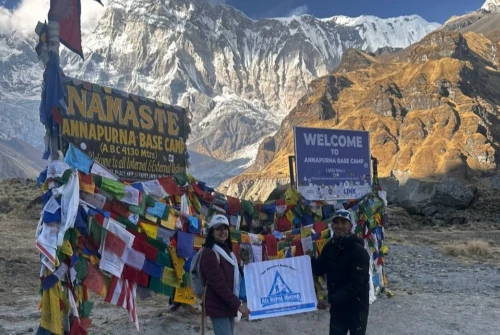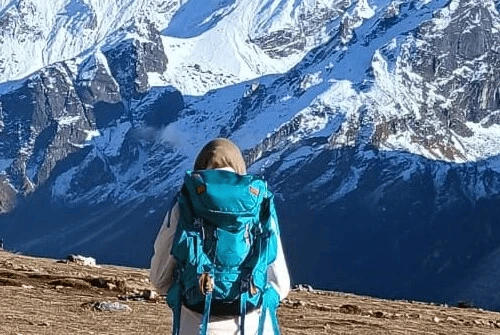Rara Lake: Nepal’s Hidden Gem
Where is Rara Lake Located?
Located in the Mugu District of Karnali Province, Rara Lake is the largest lake in Nepal. Sitting at an altitude of 2,990 meters, it’s surrounded by breathtaking mountain views and lush forests.
Why Visit Rara Lake?
Rara Lake is an off-the-beaten-path destination, providing a peaceful, secluded environment far from the crowds. Its clear waters, reflecting the nearby snow-capped peaks, make it a serene and stunning location.
Kathmandu to Rara Lake: Distance and Trek
Rara Lake is approximately 864 kilometers from Kathmandu. You can either fly to Nepalgunj and drive or trek to this remote destination. The trek through Mugu district offers a quieter, less commercialized experience of Nepal’s natural beauty.
Gokyo Lake: The Sacred High-Altitude Lake
Elevation: 4,700 to 5,000 meters
Depth: 43 meters
Best time to visit: April to June and September to November
Distance from Kathmandu: 136 km
Where is Gokyo Lake Located?
Gokyo Lake is located in the Everest Region at an elevation of 4,700 to 5,000 meters. This high-altitude lake system is one of the most famous trekking destinations for adventure lovers and spiritual seekers alike.
Why Visit Gokyo Lake?
Known for its sacred significance, Gokyo Lake is surrounded by some of the world’s highest peaks, including Mount Everest. The Gokyo Lakes trek is a must-do for trekkers seeking a more challenging and rewarding experience compared to the typical Everest Base Camp trek.
Kathmandu to Gokyo Lake: Distance and Trek
Located around 136 kilometers from Kathmandu, getting to Gokyo Lake requires a flight to Lukla, followed by a multi-day trek through the Khumbu region, passing through Sherpa villages and breathtaking landscapes.
Tilicho Lake: The Highest Lake in the World
Where is Tilicho Lake Located?
At an astonishing 4,949 meters, Tilicho Lake is the highest lake in the world, located in the Manang District of the Annapurna Range. Surrounded by majestic snow-capped peaks, this high-altitude lake is a highlight for many trekkers.
Why Visit Tilicho Lake?
The Tilicho Lake trek is one of the most challenging yet rewarding treks in Nepal. The surrounding landscapes, including rugged terrains, glaciers, and alpine meadows, make it a bucket-list destination for serious trekkers.
Kathmandu to Tilicho Lake: Distance and Trek
The trek to Tilicho Lake begins from Pokhara, where trekkers head toward Manang. The trek involves a difficult but incredibly scenic route through the Annapurna Circuit and eventually reaches the lake.
Gosaikunda Lake: A Sacred Pilgrimage
Where is Gosaikunda Lake Located?
Gosaikunda Lake sits at an elevation of 4,380 meters in the Langtang National Park, Rasuwa District. This sacred lake is a major pilgrimage site for Hindus, especially during the Janai Purnima and Ganga Dashahara festivals.
Why Visit Gosaikunda Lake?
Gosaikunda is not only spiritually significant but also stunningly beautiful. Surrounded by snow-capped peaks and rhododendron forests, this serene spot is perfect for both spiritual seekers and trekking enthusiasts.
Kathmandu to Gosaikunda Lake: Distance and Trek
The trek to Gosaikunda is a short but exhilarating journey, about 7 days from Kathmandu, starting at Dhunche. The trek offers stunning views of the Langtang Range and includes visiting small mountain villages.
Phewa Lake: Pokhara’s Iconic Jewel
Where is Phewa Lake Located?
Located in Pokhara, Phewa Lake is one of the most popular lakes in Nepal. With an elevation of 800 meters, this lake is surrounded by the majestic Machhapuchhre Himal (Fishtail Mountain), offering some of the most iconic views in Nepal.
Why Visit Phewa Lake?
Phewa Lake is known for its tranquil beauty and vibrant surroundings. You can enjoy a peaceful boat ride, visit the World Peace Pagoda, or explore the lakeside cafés and markets.
Kathmandu to Phewa Lake: Distance and Trek
It is located around 200 km from Kathmandu. You can easily reach Pokhara by flight or bus, making it an easily accessible spot to relax and enjoy Nepal’s natural beauty.
Begnas Lake: A Tranquil Retreat in Pokhara
Elevation: 602 meters
Best time to visit: September to November, March to May
Activities: Boating, fishing, hiking
Location: Pokhara
Where is Begnas Lake Located?
Another gem located in the Pokhara Valley, Begnas Lake is situated in the Kaski District of Nepal, just a few kilometers from Phewa Lake. It sits at an elevation of 600 meters and offers an equally peaceful and picturesque environment.
Why Visit Begnas Lake?
Unlike Phewa, which can be crowded, Begnas Lake provides a quieter and less touristy experience. Surrounded by lush greenery and towering mountains, it’s ideal for those seeking a peaceful retreat.
Kathmandu to Begnas Lake: Distance and Trek
Begnas Lake is only about 15 km from Pokhara and can be reached by local buses or taxis. The surrounding hills are perfect for hiking and birdwatching.
Why Visit Nepal’s Lakes?
Nepal’s lakes are not only beautiful; they’re steeped in history, culture, and spirituality. The lakes are scattered across the country, each with its unique charm and significance. Whether you're trekking to a high-altitude glacial lake or boating on a serene lakeside, these lakes offer experiences that are second to none.
Nepal is blessed with a total of 5,358 lakes spread across varying elevations, including 2,323 glacial lakes. While some of these lakes are popular tourist destinations, others remain hidden gems waiting to be discovered. Whether you’re an experienced trekker or a leisure traveler, there’s a lake in Nepal for you to explore.
Honorary Mentions:
Why Choose All Nepal Hiking?
If you are ready to experience these breathtaking lakes and the surrounding beauty, All Nepal Hiking is here to help. With expertly crafted itineraries and knowledgeable guides, we can make your journey through Nepal's lakes unforgettable. Whether it’s a trek to the remote Gokyo Lake or a peaceful retreat by Phewa Lake, we’ve got the perfect adventure waiting for you.
Book your trip now and create memories that will last a lifetime! Reach out to us at [email protected] for more details or to customize your own Himalayan adventure.
FAQs for Treks to the Beautiful Lakes in Nepal
1. What are the most popular lakes for trekking in Nepal?
Some of the most popular lakes for trekking include Rara Lake, Tilicho Lake, Gokyo Lakes, Gosaikunda Lake, and Phewa Lake. Each offers unique scenic views and trekking experiences.
2. How long does it take to trek to Rara Lake?
3. What is the difficulty level of trekking to Tilicho Lake?
The trek to Tilicho Lake is considered challenging due to its high altitude (4,949m) and demanding terrain. It requires a good level of fitness and acclimatization, typically taking around 12 to 15 days.
4. Do I need permits for trekking to Gosaikunda Lake?
5. What is the best time to trek to lakes in Nepal?
The best time to trek to Nepal's lakes is during the pre-monsoon (March to May) and post-monsoon (September to November) seasons. The weather is clear, and the temperature is mild, making it ideal for trekking.
6. What is the elevation of Gokyo Lake, and how difficult is the trek?
7. Is it safe to trek to high-altitude lakes in Nepal?
While trekking to high-altitude lakes like Rara Lake, Tilicho Lake, and Gosaikunda Lake is generally safe, trekkers should be prepared for altitude sickness. It’s essential to acclimatize properly, stay hydrated, and take rest days as needed.
8. Can I trek to Phewa Lake on my own, or do I need a guide?
Phewa Lake in Pokhara is easily accessible and doesn’t require a guide. However, if you wish to explore nearby trekking routes like the World Peace Pagoda or do an extended trek, a guide is recommended.
9. How do I get to Rara Lake from Kathmandu?
To reach Rara Lake, you’ll need to take a flight from Kathmandu to Nepalgunj and then to Mugu. From Mugu, it’s a 4-5 days trek to the lake, depending on your route.
10. What should I pack for trekking to Nepal’s lakes?
You should pack lightweight, moisture-wicking clothes, a good pair of trekking boots, a sleeping bag, a jacket, sunscreen, water purification tablets, a first-aid kit, and snacks. A trekking pole is also helpful for uneven terrain.
11. Are there any accommodations on the trekking routes to lakes?
12. Can I trek to these lakes in winter?
While trekking to lakes like Phewa Lake is possible year-round, trekking to higher-altitude lakes such as Tilicho Lake, Gosaikunda, or Gokyo Lake is best avoided during winter (December to February) due to heavy snow, freezing temperatures, and risky conditions.
Conclusion: Explore the Wonders of Nepal’s Lakes
Nepal’s lakes are not only serene and stunning but also hold deep cultural, spiritual, and natural significance. Whether you’re seeking adventure on a high-altitude trek, a peaceful getaway by the water, or a spiritually enlightening experience, these top 6 lakes in Nepal will provide you with unforgettable memories.
From the remote and peaceful Rara Lake to the sacred and challenging Gosaikunda and Tilicho lakes, each offers its own unique experience. Book your trek today and immerse yourself in the beauty and tranquility of these stunning Nepalese lakes.
For personalized tours, expert guides, and safe trekking experiences, contact All Nepal Hiking to start planning your adventure.




